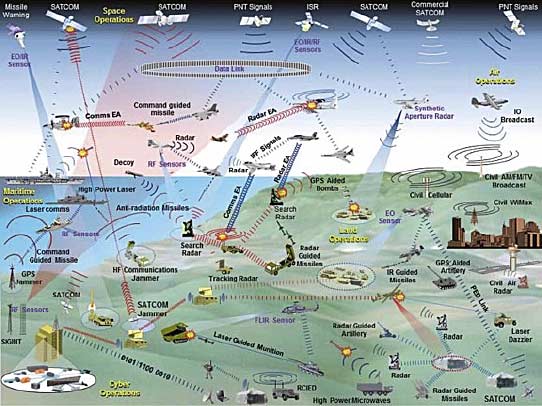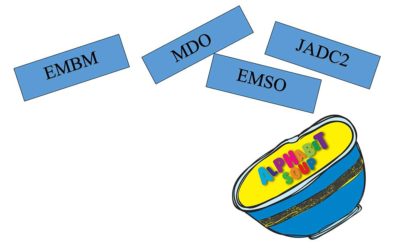The classic components of electromagnetic warfare (EW) include:
- Electromagnetic Attack (EA)
- Electromagnetic Protect (EP)
- Electromagnetic Support (ES)
With these abbreviations, it’s easy to assume that each component consists of the same thing: systems. That assumption causes misunderstanding in the defense community, and it is time to set the record straight about these three pillars of EW.
- EA systems consist of Offensive EA, which are systems that guide missiles to targets, and Defensive EA, including self-protection jamming against enemy threats;
- EP features are capabilities infused into EA and ES systems that fortify systems to improve their access the spectrum, despite being jammed or constrained. Misunderstanding EP as a self-protection platform must end now;
- ES systems detect, collect and analyze signals to conduct military operations.
Because EA and ES capabilities are firmly enabled by building systems, it’s easy to misplace EP as also being enabled by building systems. It is not. EP is enabled by enhancing and equipping all spectrum-dependent systems with features that fortify those system’s ability to access the electromagnetic spectrum (EMS), especially when the spectrum is contested, congested or denied (jammed).
In the words of Mr. David Tremper, OUSD A&S at CEMA 2021 just a few weeks ago, “EP is doctrinally part of the EW portfolio, but it really shouldn’t be [anymore]. EP features belong on every spectrum-dependent system, not just EW systems.”
When Electronic Warfare began about 70 years ago, leaders in the field realized that protecting use of the EMS was a critical part of being successful. So, they included an element that spoke to preserving that capability: Electronic Protect. With very rudimentary technologies available, preserving use of the spectrum was rather simple to plan for. There were only two types of systems that were being operated and needed access to the EMS: comms radios and jammers (note, no GPS, no digital data links). The way EP got implemented on those systems was as follows:
- Enhance EA and ES systems with larger amplifiers (to transmit at higher power)
- Mask signal emissions from radios to avoid detection (so we wouldn’t be jammed)
- Anticipate enemy use of jamming signals and build radars and radios to emit outside those bands.
There was a fourth essential component that didn’t fall directly in EP but got carried along as missions were planned. It was called, “graceful degradation techniques,” and they were used if and when access to the spectrum was denied. The mission could carry on with back-up plans not using the spectrum (e.g. hand signals, pre-arranged meeting coordinates).
EP’s complexity continues to grow. There are significantly more spectrum-dependent systems being used for military operations today than there were 40 years ago (think cell phones, laptops, tablets, GPS, Android Blue Force Tracker). This resulted in an explosion of systems being brought to the battlefront in a very short amount of time. Even more imminent is the need to have these spectrum-dependent systems at the foundation of EMBM: Electromagnetic Battle Management. It is these types of systems that will transmit crucial situational data to the operations center to be stitched together to form a situational awareness (SA) picture for the battle commanders to make C2 decisions – command and control.
What is the challenge now? EP features were made a requirement in the 2018 JCIDS Manual (see pages 119 and 180). However, as budgets and program teams struggled to keep up with expanding R&D and production schedules, EP features got put on the back burner as a “nice to have.”
Why did a bona fide requirement for EP get left behind? There are several reasons. First, EP doesn’t explode onto the nightly news. It isn’t sexy and it doesn’t tend to get people looking (like fighter planes do). EP is essentially invisible. The invisible enemy is so much harder to address (think Star Trek, Season 1, Episode 23, “A Taste of Armageddon.”)
Second, in the Gulf War in the 2000s our warfighters operated with genuine impunity when it came to using the spectrum . In fact, our access to and use of the electromagnetic spectrum hasn’t been jammed in military conflict on a large scale since the Cold War. This meant we could show up with our new toys, turn on the power switch and fire away (or talk, or target, or surf the ’net) with the assumption the EMS would always be there.
Third, the U.S. perceived that we were the technology leaders in designing and deploying EMS-dependent systems for military operations. We were blind to other countries designing countermeasures quickly enough to preclude our use of these spectrum-dependent systems.
Over the last 20 years, our adversaries have been watching us very closely in the Middle East:
- They made note (live and firsthand) of our tactics, techniques and procedures (TTPs) for using spectrum-dependent systems
- They watched our growing dependence on EMS
- They recorded signal emissions and analyzed them for vulnerabilities
- They developed devices to singularly and fervently deny our systems access to the EMS
- They used our emissions and communications to target us and launch kinetic weapons (similar to how Russia invaded the Ukraine)
- They bragged about this in public forums.
We didn’t fortify all our EMS-dependent systems with EP features, so when we get our EA and ES systems out to the theatre, they may not work. Neither will our GPS, Comms radios, or data link radios. What then?
First, we must start referring to EP in the EW triad as “EP features.” This is critical to communicating the right message: urgency, culture and respect for the importance of EP features. To bring this point home, consider a new look at the EW triad:
- EA
- EP features
- ES
Second, we need to design, develop and deploy features that will improve our ability to maneuver freely (and/or out-maneuver our adversaries) in a contested, congested, denied EMS. We will need features that enable:
- Spectrum awareness and monitoring (e.g. the Army’s Electronic Warfare Planning and Management Tool (EWPMT), the Navy’s Real-Time Spectrum Operations and the Marines SSF )
- Alternative navigation techniques to GPS (because GPS is so easily spoofed and jammed)
- Alternatives to RF transmission (e.g., line-of sight comms using laser/Electro-Optics (EO))
- Alternatives to Fourier Transform modeling of the EMS, which significantly limits our capacity and Freedom of Action in the EMS
Third, we should have a basic understanding of what our options are for EP features. Here are some of the more prominent and urgently needed ones:
- Autonomous Dynamic Spectrum Access
- Artificial intelligence and machine learning are essential to process at the speeds needed to access the spectrum (Spectrum Awareness is fundamental to achieving this ability)
- Laser communications & infrared (and capabilities other than in the RF portion of the spectrum, notionally frequencies that haven’t been over-used to preserve the element of surprise)
- Entire networks (think Air Force’s Advanced Battle Management System (ABMS), Army’s Electronic Warfare Planning and Management Tool (EWPMT)) built with resilience and novel approaches to frequency use
This list will grow. As we encounter adversaries’ measures to deny us access to the spectrum, this will spawn additional needed features.
If and when an adversary is successful at denying us access to the spectrum, we will need alternatives to transmitting at all: hand signals, written notes, CONOPS mission intent, TTPs (think Army PACE). Cold War tactics are a good place to start. These are mostly non-technical solutions and should be fashioned by former operators who experienced large-scale spectrum jamming.
It is imperative that everyone making key decisions in this realm understand the full breadth and depth of EP features: military leaders, congresspeople, operators and program managers. Enforce EMS Survivability policy to bring about the inclusion of EP features on every spectrum-dependent system (and no more waivers!).
It cannot be a “nice to have” anymore. We need congressional funding urgently guided toward R&D of EP features and TRL 4-7 enhancements of EA and ES systems with EP features. Yes, we may have to pull the skin off aircraft, the metal off boxes and reprogram the ASICs . That’s a tough pill to swallow, but our ability to access the EMS depends on it.
Whenever you think of EW going forward, think EA, EP features, ES. Our ability to achieve Freedom of Action in the EMS depends on it.
Current Doctrine for EA, EP, ES
(JP 3-85) Electromagnetic Attack (EA). Division of electromagnetic warfare involving the use of electromagnetic energy, directed energy, or antiradiation weapons to attack personnel, facilities, or equipment with the intent of degrading, neutralizing, or destroying enemy combat capability and is considered a form of fires.
(JP 3-85) Electromagnetic Protection (EP). Division of electromagnetic warfare involving actions taken to protect personnel, facilities, and equipment from any effects of friendly or enemy use of the electromagnetic spectrum that degrade, neutralize, or destroy friendly combat capability. Also called EP.
(JP 3-85) Electromagnetic Support (ES). Division of electromagnetic warfare involving actions tasked by, or under direct control of, an operational commander to search for, intercept, identify, and locate or localize sources of intentional and unintentional radiated electromagnetic energy for the purpose of immediate threat recognition, targeting, planning and conduct of future operations.





• EP features are capabilities infused into any electromagnetic sensor, communication or EW systems that fortify systems to maintain their access the spectrum, despite being jammed or constrained. Misunderstanding EP as a self-protection platform must end now;
• EA systems consist of Offensive EA, which are systems electromagnetically engages adversarial sensors, communications or weapons by disrupting, degrading or denying electromagnetic spectrum access, and Defensive EA, including self-protection jamming against hostile actions and threats;